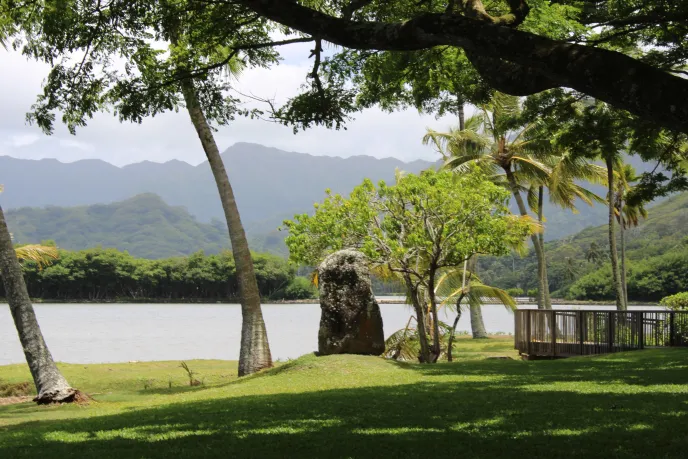Aquaculture in Modern Hawai'i Using Ancient Fishponds

Moliʻi Pond, a one hundred and twenty-eight acre fishpond that is part of Kualoa Ranch, on Oʻahu. Image courtesy of Grace Cajski.
Each year, the Yale Environmental Humanities program awards small grants ($250–$2,000) to students, faculty, and eligible staff to support public humanities projects broadly related to the environment. In this blog post, Yale undergraduate Grace Cajski writes about her grant-funded project, ‘Talking Story: How Hawaiʻi’s Modern Aquaculturists Discovered a Solution to the Future in Their Past.’ Grace’s project aims to capture and preserve the knowledge of aging Hawaiian aquaculturists, which may otherwise be lost.
--
Ancient Hawaiian fishponds fall at the nexus of culture, climate, sustainability, coastal restoration, politics, and safety. They are the oldest form of aquaculture in the Pacific Rim and were nearly lost to colonization and time. Modern Hawaiian fishpond caretakers have rediscovered the art of caring for these ponds, and, in the process, are renewing a means of establishing food sovereignty and food security. They are restoring the sea and the land, and they are uplifting Hawaiian culture.
In February 2021, I received a grant from the Yale Environmental Humanities Program to embark upon a project to write about fishponds, entitled ‘Talking Story: How Hawaiʻi’s Modern Aquaculturists Discovered a Solution to the Future in Their Past.’ The research for this project is also made possible through the generosity of the Yale Law School’s Law, Ethics & Animals (LEAP) Student Grant Program, the Yale Sustainable Food Program’s Global Food Fellowship, and the Yale CIPE Summer Journalism Fellowship. Talking Story seeks to document the research, toil, discoveries, and art of Hawaiʻi’s modern aquaculturists as they strive, investigating the wisdom of their ancestors and discovering their own knowledge, to find the answers to the anthropocene’s problems. It is a product of passion and curiosity, in addition to duty and frustration: in the aquaculturists themselves, in Hawaiʻi’s elders, in scientists, in myself.
I started learning about fishponds in September 2020 while interning for the Hawaiʻi Institute of Marine Biology. As I learned more, I came to understand that today’s fishpond operators are contending with some fascinating and complex problems rooted both in the past and the future. Colonization destroyed so much knowledge of fishponds, and operators are still working to relearn it. Climate change, overpopulation, pollution, and poor land management have and will alter the environments in which fishponds exist. Fishponds must address both leagues of issues simultaneously. As they do so, they can act as solutions to impending threats: they can mitigate and adapt to climate change, becoming sources of sustainability, carbon neutrality, and carbon sinks; they can help feed an overpopulated world sustainably; and they can make efficient use of limited resources. Fishponds are sources of deep intrigue, vast history, intricate culture, and enduring solutions.
The people who work at and with them are resilient, hard working, kind, passionate, driven, generous, hilarious—even legendary. Talking Story delves into the aquaculturists’ stories and their work, bringing their philosophies and knowledge to a wide audience. It offers solutions, illuminates challenges, and celebrates Hawaiian culture. I spent thirty-five days on Oʻahu and spoke with more than forty fishpond caretakers, scientists, nonprofit leaders, civil servants, community members, conservationists, and educators.
Two pieces of writing are forthcoming that target diverse audiences that would not otherwise know about fishponds and their stories. The first is a piece forthcoming in ECO Magazine, a marine science publication that is widely read by marine scientists and professionals. The second is forthcoming in the Yale Program for Climate Change Communication blog, a publication read by university students, climate change activists, and scientists. Additionally, the project blog documents each day’s interviews and discoveries.
As the aquaculturists age, and as their projects seek more support, it is imperative that their stories get told and their knowledge gets recorded. Most importantly, transcripts from interviews with kupuna, or elders, will be made available to the public through the University of Mānoa’s Center for Oral History webpage. Anyone who wants to hear the story from the kupuna themselves will be able to do so. The world has slowly started to embrace indigenous knowledge. This project underscores the intelligence, observation, and hard work that enabled fishponds to flourish, and it confirms the scientific prowess of the ancient Hawaiians. My hope is that this work will help uplift their voices and celebrate their accomplishments.
I am grateful to have had the opportunity to witness and take part in such work. I am grateful to have met and connected with so many inspiring figures. I am humbled by the privilege of hearing their stories, and telling them.
Grace Cajski is a student at Yale College studying English and Environmental Studies. She is passionate about marine conservation, and she believes that storytelling is a powerful tool to evoke empathy and garner support.